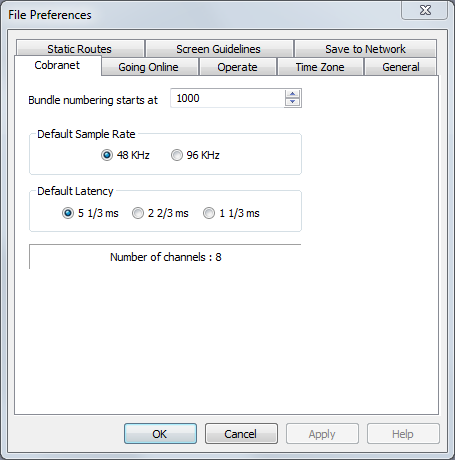

These settings are for the network audio behaviour of the design file. The CobraNet bundle start numbering can be adjusted here (default is 1000).
The default audio sample rate across the network can be set here (choose between the standard 48kHz and the higher quality, but higher overhead, 96kHz). As new BLU processors are dragged into the design they will take their default sample rate from this setting. However, devices can be run at the other sample rate as long as they are only connected to other processors using the same sample rate.
There is also a selection of 3 possible latency settings, this is the finite time that audio takes to pass thru a network device and, if much processing is involved this can very slightly delay the audio in the system. The maximum latency incurred in a CobraNet network is 256 samples (5-1/3ms) at the receiving CM-1 card. This latency can be reduced at the expense of CobraNet audio channels transmittable from device to device and all units on the network must be configured to operate at this latency.
NB:This capability will be borne out so long as fewer than 6 switch hops are used on a 100BaseT network. Greater than 6 switch hops may incur more delay. On a Gigabit network you may be able to have 15 switch hops before incurring additional delay.
A CobraNet network utilising the CM-1 module can make use of a number of possible latency times and sample rates.
Latency against sample rate at 20-bit resolution
Latency |
Sample Rate |
Bit Resolution |
CM-1 Channel Capacity |
5-1/3ms |
48kHz |
20 |
32 In, 32 Out |
5-1/3ms |
96kHz |
20 |
16 In, 16 Out |
2-2/3ms |
48kHz |
20 |
32 In, 32 Out |
2-2/3ms |
96kHz |
20 |
16 In, 16 Out |
1-1/3ms |
48kHz |
20 |
32 In, 32 Out |
1-1/3ms |
96kHz |
20 |
16 In, 16 Out |